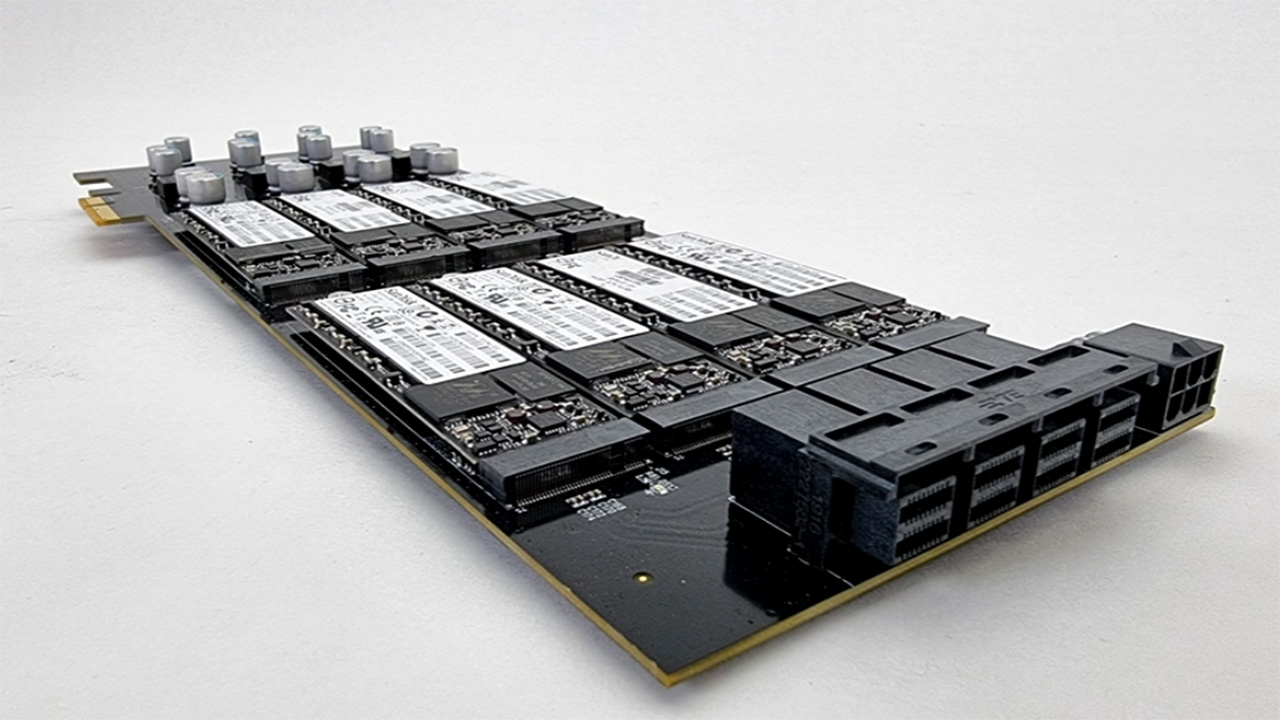Storage Scaler Crams 16 SSDs Into One Board
Chia farm or Ultimate Steam Library?
How many M.2 drives is too many M.2 drives? That’s a question this Kickstarter project from Apex Storage (as noticed by Hackster) attempts to answer: the Storage Scaler crams 16 SATA M.2 drives onto one PCIe board.

The crowdfunding campaign has 25 days to go as we write, and has reached about a sixth of its goal. What you get for your money, with the usual crowdfunding caveats applied, is a PCIe board with space for 16 M.2 sticks. These SATA drives then talk to the host PC through four SFF-8643 SATA connectors, for a total of 16 6Gbps connections. Power comes from the x4 PCIe slot the card rests in, along with a six-pin feed from the PSU of the type often used to power graphics cards.
It requires an external SATA HBA or RAID card to work, as it has no built-in drive controller. In RAID mode, it offers up to 7,377 MB/s read and 5,712 MB/s write. In HBA mode it can be configured as software RAID, JBOD, or as individual drives through OS disk management.
Potential applications include high-res video editing, storage caching, and mining storage-based cryptocurrencies such as Chia. By using SATA rather than NVME drives, the hope is to keep costs down and increase returns.
Orders should begin shipping in October. Remember that crowdfunding a project is not a guarantee of receiving a finished product. Backing a crowdfunded project is akin to an investment, you believe in the project and want it to succeed. You are not purchasing a retail product.
Get Tom's Hardware's best news and in-depth reviews, straight to your inbox.

Ian Evenden is a UK-based news writer for Tom’s Hardware US. He’ll write about anything, but stories about Raspberry Pi and DIY robots seem to find their way to him.
-
mras2 From article:Reply
"It requires an external SATA HBA or RAID card to work, as it has no built-in drive controller. In RAID mode, it offers up to 7,377 MB/s read and 5,712 MB/s write. "
This is not true.
The 'test' configuration at their kickstarer page has a test with 16x samsung 850 where it gives those numbers.
These are not the "up to" numbers.
The "up to numbers" are defined by the sas standard, that gives you 1.5GB/sec(12gbit/s) pr channel, times 4 channel pr port, times 4 ports => 24GB/Sec.
( These are theoretical numbers, real numbers will ofcause depend on overhead of SAS standard, your SAS card, and your attached M.2 devices )
But, it's still vastly more than the stated 7377/5712MB/sec -
spongiemaster Reply
The card uses SATA III M.2 drives. That's a theoretical maximum data transfer speed of 600MB/s per drive with real world closer to 550MB/s. For 16 drives, the theoretical max would be 9.6GB/s, which isn't all that much higher than the 7.4GB/s stated in the article.mras2 said:From article:
"It requires an external SATA HBA or RAID card to work, as it has no built-in drive controller. In RAID mode, it offers up to 7,377 MB/s read and 5,712 MB/s write. "
This is not true.
The 'test' configuration at their kickstarer page has a test with 16x samsung 850 where it gives those numbers.
These are not the "up to" numbers.
The "up to numbers" are defined by the sas standard, that gives you 1.5GB/sec(12gbit/s) pr channel, times 4 channel pr port, times 4 ports => 24GB/Sec.
( These are theoretical numbers, real numbers will ofcause depend on overhead of SAS standard, your SAS card, and your attached M.2 devices )
But, it's still vastly more than the stated 7377/5712MB/sec -
mras2 Reply
Yeah, the SATA 3 standard, unfortunately limits it to yours stated 9600MB/sec~spongiemaster said:The card uses SATA III M.2 drives. That's a theoretical maximum data transfer speed of 600MB/s per drive with real world closer to 550MB/s. For 16 drives, the theoretical max would be 9.6GB/s, which isn't all that much higher than the 7.4GB/s stated in the article.
Wonder if a multiplexor bridge chip is to expensive, since two of those connectors, could easely fullfll those bandwith requirements.
I'm guessing SATA3 physical ports must be too expensive, since they opted for the SAS3 ports?
But no matter what, then the stated "up to" numbers, doesn't fit. -
deesider Reply
Yeah exactly - a bit behind the times. Major manufacturers have stopped making M2 SATA driveskal326 said:Was interesting up until the words “M2 SATA” showed up. -
USAFRet Reply
Really?deesider said:Yeah exactly - a bit behind the times. Major manufacturers have stopped making M2 SATA drives
https://www.samsung.com/us/computing/memory-storage/solid-state-drives/ssd-860-evo-m-2-sata-250gb-mz-n6e250bw/ -
deesider Reply
Yes - that is Samsung's 'latest' SATA M2 drives launched in 2017. Local retailers advise that when current stock is sold out, will not be replaced. So if you need one get it while you can.USAFRet said:Really?
https://www.samsung.com/us/computing/memory-storage/solid-state-drives/ssd-860-evo-m-2-sata-250gb-mz-n6e250bw/
https://www.anandtech.com/show/9799/best-ssdsThe Crucial MX500 M.2 has been discontinued and Samsung has made no mention of a M.2 SATA version of the new 870 EVO, so it's pretty clear that this form factor has reached end of life. Consumers who need a capacity upgrade for a notebook that doesn't support NVMe on its M.2 slot should probably upgrade this year while new M.2 SATA drives are still readily available at reasonable prices.
-
USAFRet OK, I stand corrected on the M.2 SATA.Reply
And completely reasonable that they are going away. -
expunged They would have been better off ditching the raid card and sata3 and using Samsung's 8nm PCIE 4.0 controller with a 16x interface. But then your issue becomes PCIE lanes. With most CPUs coming in around 24 lanes unless you go threadripper or intel extreme series.Reply